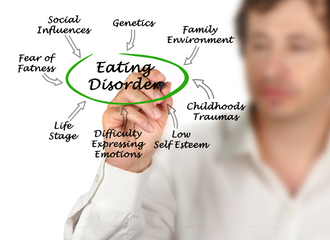Written by: Lindsay Breeden, PhD
Residential Clinical Supervisor, The Renfrew Center

As a school professional, it is critical for you to be familiar with the different types of eating disorders, signs and symptoms, early intervention, and preventative education. Eating disorders have one of the highest mortality rates of any mental disorder, and you are in a unique position to detect early onset and guide the student and their family towards lifesaving treatment.
It is estimated that as many as 30 million individuals in the United States will develop an eating disorder at some point during their lifetime. Affecting both physical and mental health, eating disorders are complex illnesses with biological, genetic, psychological, psychosocial, cultural, and developmental roots.
What Causes Eating Disorders in Students?
There is never a single cause for the development of an eating disorder. Rather, underlying causes involve interactions of biological, psychological and social factors unique to each person. People are especially vulnerable to developing eating disorders during transition periods, such as moving from middle to high school. Changing the shape and size of the body cannot solve these challenges, however perfectionism can become the go-to strategy for coping with emotions and psychological issues. Eating disorders are often a vehicle to obtain control when the rest of one’s life feels out of control.
What Are the Most Common Eating Disorders Among Students?
The most common eating disorders are anorexia nervosa, bulimia nervosa and binge eating disorder.
Anorexia (clinically known as anorexia nervosa) is self-imposed starvation. Adolescents with anorexia are often profoundly dissatisfied with their body image and usually express a strong desire to lose weight. One of the key features of this disorder is denial. Although obsessed with food, they continually deny their hunger and are not able to recognize that they are suffering both physically and emotionally. Anorexia is categorized into two types: restricting type and binge/purge type. Anorexia can affect anyone at any age, weight, race, or gender despite the enduring myth that only thin, white, teenage girls are at risk.
Bulimia (clinically known as bulimia nervosa) is the repeated cycle of out-of-control eating followed by some form of purging to compensate for what was consumed. Examples of purging include self-induced vomiting, excessive use of laxatives or diuretics, or obsessive exercising. Adolescents with bulimia are preoccupied with their shape, weight, and body image as a source of self-esteem.
Binge eating disorder (also known as BED or compulsive overeating) is uncontrolled eating or bingeing followed by periods of guilt and depression. A binge is marked by the consumption of large amounts of food, sometimes accompanied by a pressured, “frenzied” feeling. Unlike bulimia nervosa, BED does not involve purging, excessive exercise or other behaviors to compensate for the binge episode.
What Signs & Symptoms Should School Professionals Look For?
Below are some of the warning signs for the most common eating disorders. A student may have symptoms of more than one diagnosis or may not fully meet the diagnostic criteria for one specific disorder but may still need help.
An individual with anorexia commonly:
- Diets or avoids entire food groups in an attempt to lose weight
- Uses the scale frequently to monitor weight
- Has a distorted body image
- Feels cold or has thinning hair
- Discusses food, cooking or dieting excessively
- Exercises even when tired or injured
- Overvalues weight as a basis for self-esteem
An individual with bulimia commonly:
- Eats large amounts of food in a discrete period of time
- Uses the bathroom frequently after meals
- Engages in vomiting, laxative or exercise abuse
- Reacts to stress by bingeing
- Experiences frequent fluctuations in weight
- Overvalues weight as a basis for self-esteem
- Has swollen salivary glands on either side of the face
An individual with binge eating disorder commonly:
- Consumes large amounts of food when not physically hungry
- Turns to food as a way of coping with feelings
- Eats rapidly or excessively
- Eats to the point of feeling sick or uncomfortably full
- Often has meals alone because of shame or embarrassment
- Shows signs of depression and withdrawal and has extreme feelings of guilt and shame after eating
- Has high blood pressure
Other signs that you may notice at school could include social withdrawal, irritability, grade changes, and repeated absences.
How Can You Help Intervene?

Research shows the sooner an eating disorder is diagnosed and addressed the more likely treatment will lead to sustained recovery. Don’t shy away from expressing your concerns, but recognize that a trusting relationship will make this easier.
Comment on behavior, not appearance
Curb your impulse to comment on weight or appearance; at their root, eating disorders are emotional disorders. Express concerns about general well-being first and then name the behaviors that trouble you. For example: “I have noticed you do not seem happy lately, and I’m concerned something’s bothering you. You seem tired and distracted. I have not seen you at lunch for a while. Have you been having some problems eating?”
Be patient and empathetic
Remember, denial and shame accompany eating disorders. Remain non-judgmental, avoid pressing too hard, leave the door open for future conversations, and continue to be aware of the student’s behavior at school.
Know when to contact parents
Depending on your level of concern, and considering both regulations and professional ethics, you should consider contacting parents. With full-blown eating disorders, the stakes are too high to keep quiet.
How Can You Aid the Treatment Process?
When deciding on the best course of treatment, it is important for the parents/guardians and referring healthcare professionals to select a program (or combination of programs) that specializes in treating eating disorders and allows the student to thrive.
As a school professional you should:
- Be aware of local providers and make referrals to an eating disorder team, including a therapist, a dietician, and a psychiatrist.
- Be familiar with the different levels of treatment: inpatient and residential facilities are the most comprehensive programs with 24-hour care. Day treatment or partial hospitalization programs (PHP) provide intense structure and support during the day and allow the patient to return home in the evening. Intensive outpatient programs (IOP) offer a structured environment for students to seek treatment a few days a week, and many programs offer the option to attend in the evenings.
- Coordinate educational needs with providers when appropriate, particularly if a student requires residential or day treatment and will be away from school for an extended period of time.
How Can You Help with Recovery?

- Providing the student with a safe environment (perhaps the nurse’s office) to eat lunch and snacks.
- Allowing frequent access to in-school support services while not enabling school avoidance.
- Consider implementing a 504 Plan to help a student meet academic goals if frequent absences for treatment are required. For example, it may help to decrease course load, minimize homework when a student attends a treatment program or extend time for testing if test anxiety exists.
Furthermore, school professionals should also be involved in providing preventative education.
- Educate staff about eating disorders, disordered eating, diet culture, weight stigma, fat phobia, and the importance of promoting body inclusivity. Some schools have used in-services or faculty meetings for these trainings.
- Avoid discussing weight or BMI with students, as there are much more reliable measures of wellness. Research has shown that the effects of weight stigma and weight discrimination negatively impacts mental health, decreases one’s willingness to utilize healthcare services in the future, and increases disordered eating behaviors.
- If resources are available, consider implementing an evidence-based preventative program for students to explore and openly discuss issues related to the thin ideal, media literacy, appearance, and body image. Research suggests that preventative programs like The Body Project can help students improve self-esteem and reduce various forms of disordered eating.
- Publicize outside groups and programs of interest, such as National Eating Disorder Awareness Week held each February.
Conclusion
Eating disorders can be a matter of life or death. During a transitional period of life such as middle school or high school, the risk of developing harmful behaviors can be exacerbated. Knowing the signs and symptoms and providing early intervention can give students the opportunity to fully recover and lead a successful life free from the restraints of an eating disorder.







